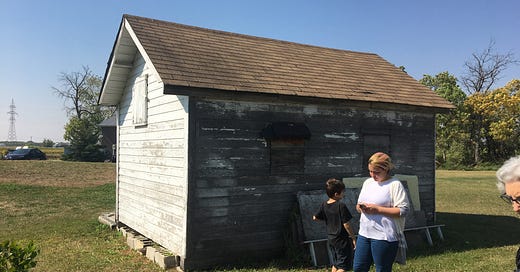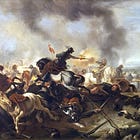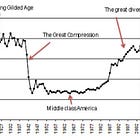1000 followers. Thank you!
Here's a few of my "Greatest Hits"
I just noticed that I just went over 1,000 subscribers. Thank you!
I started this substack immediately after losing an election last year. Personally it was an extremely difficult, because one of the reasons I went into public life was that I saw a crisis coming and I hoped to be able to have a platform where I could speak up, and, at least, warn people.
I have been extremely concerned about democracy being undermined, and understanding the economic forces that drive it, and most of all, what can be done to avert disasters.
Prior to politics I lectured at a local university and I have been a policy researcher for about 30 years.
I was born in 1969 and am a Generation X-er. My grandparents on both sides lived through the First World War, the Spanish Flu Pandemic of 1918, the Depression and the Second World War. They were all middle class. In good times, we went up, and in bad times, we went down. In 1906, my paternal grandfather, born in 1885, moved to Winnipeg, Manitoba Canada, gateway to the Canadian West and a boom town with more millionaires per capita than any other city in Canada.
That boom crashed - in stages. My grandfather went to university, got a scholarship and earned a Master’s, then a law degree. He was in Belgium and helped liberate the town of Mons on November 11, 1918. After the War, he married May Bastin, and they started having children.
In 1929, Wall Street crashed and took the entire global economy with it. Western Canada, where we live, was one of the hardest hit areas in the world. The provinces counted on high grain prices, which had generated incredible wealth for “grain barons” but when the price plunged, so did the flow of money.
My father was born in 1933, at which point my grandfather, grandmother and his four older siblings were living in this sturdy grain shed, which had a porch built around it.
However, by the end of the Second World War, and into the 40s and 50s, Canada and the U.S. had not only recovered and the Great Depression ended.
What followed was called “the golden age of capitalism” where as the economy grew, it tended to grow for everyone. That changed with the crises of the 1970s, when an entirely new economic operating system was “installed,” which was a return to the economic ideas and policies before the New Deal. Called “neoliberalism” its “neoclassical economics” referred to old “classical liberal” ideas and “classical economics.”
The reason for installing this massive, quasi-libertarian programme, at least in central banks, economics departments and in central banks, as well as imposing fiscal restraints on elected governments, was that the previous economic models had not predicted “stagflation” inflation going up, while wages didn’t.
The irony is that it was at that very point - around 1978 - that incomes for workers and managers started to diverge, and the inequality has been growing ever since. The cure to “stagflation” was a set of economic rules that have created nearly five decades of stagflation.
After the 2008 global financial crisis, I started reading and studying that event, which generated an enormous amount of good work and criticism, especially from the UK, which was extremely hard hit.
I started to write a manuscript to keep track of my thoughts and ideas partly because I worked in the policy development, and I wanted to be able to provide solutions to what I perceived (and still perceive) as being a trap.
The question is whether there is a way out that is a positive alternative - or any alternative to the current economic responses. The basic argument is that we must have a so-called “free market” economy, which to the private sector means that the distribution of income and wealth is determined by the private sector, and that the government can then redistribute some of it to compensate people who experience losses as a result of the market’s “efficiencies”.
It’s important to say that I don’t believe our current economics are economics at all. They don’t model money, or banks, or private debt, or unemployment.
They are really just a set of prescriptive rules for a way that an economy must be run, that are not based in evidence or history.
So, I wanted to give you a few of my Greatest Hits that tell the story of what I have learned, and why there is hope.
First, people ask how we can be so divided? One of the answers is that throughout history, financial collapses lead to bitter political divisions. Many wars are preceded by financial crises that lead to desperate populations - a desperation that has been misunderstood and minimized for centuries.
The next question is, what can you do about a massive crisis? When people propose that central banks create money for the purpose of helping the economy, the answer is almost inevitably that that was tried in Germany in the 1920s, and it resulted in hyperinflation.
In fact, that history is completely wrong. After the war, the German central bank was privatized, and banks were allowed to issue credit that could be traded in for official money. It was private banks printing money that caused German hyperinflation - not the government. When a new currency was introduced, the hyperinflation stopped and Germany had the fastest growing economy in the world.
It wasn’t hyperinflation that led to the Nazis taking power in Germany: it was austerity.
The USSR, cut off from global finance, was actually experiencing better growth in the 1930s than democratic and capitalist countries.
However, one of the more surprising stories about the Soviet Economy is that it was not “Keynesian” nor did it strive to achieve economic equality. Rather, it is the same trickle down economics as libertarian capitalism, except the surplus all goes to the state, instead of to capitalists.
That brings me to the insights that, to me, are the most important: what people did right to fix the problem.
The only time inequality improved in the U.S. and in Canada was during the period 1938-1945, the so-called “Great Compression.” Yes, it was a wartime effort - but there is not, technically any reason why these measures could be enacted today.
That changed in the 1970s - with a return to economics and the determination to tear down everything the New Deal built. The fundamental basis of this new ideology was that, instead of borrowing or taxing people with means and funding public projects for the benefit of all, that the economy would be funded by individual consumers, who would do so by taking on personal debt.
The 2008 Global Financial Crisis was caused by mortgages failing. In 1929, there had been a housing and property boom, too.
Keynes and others have written that financial crises are caused by people borrowing money to speculate on whether an asset will increase in price or not. Houses are non-productive, non-revenue generating assets. So when you borrow more and more to buy them, the only way to make money is if the prices keep going up.
The response to the 2008-2009 global financial crisis was to paper over it. We did not address it - and central banks did not even update their models, though virtually none of them predicted the crash. In the last 15 years, central banks have created over $20-trillion to bail out financial institutions - investors whose investments failed.
Aside from being a truly extraordinary sum, QE also shows that the Neo-classical economics we have been pursuing are a sham. Not can we build a better world, we already have the tools to do it.
Thank you for your support. I am doing this work on the side, and if you are interested please consider signing up for a paid subscription.
30 -













Great stuff Dougald! You are one of the very best writers I have encountered on Substack.